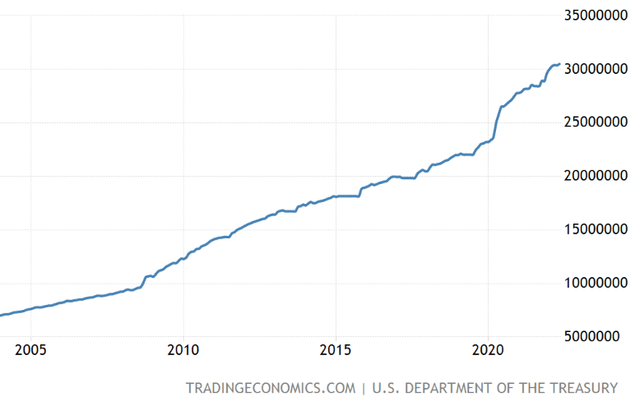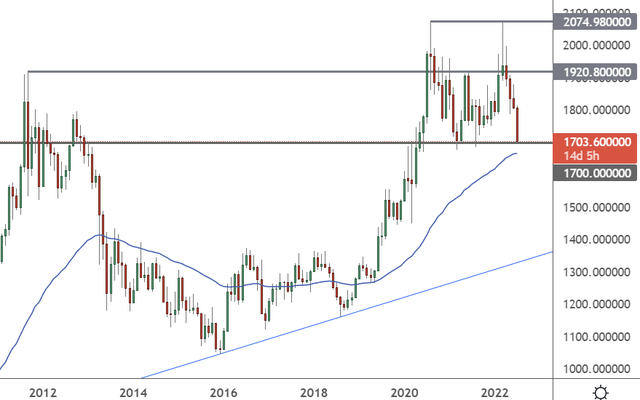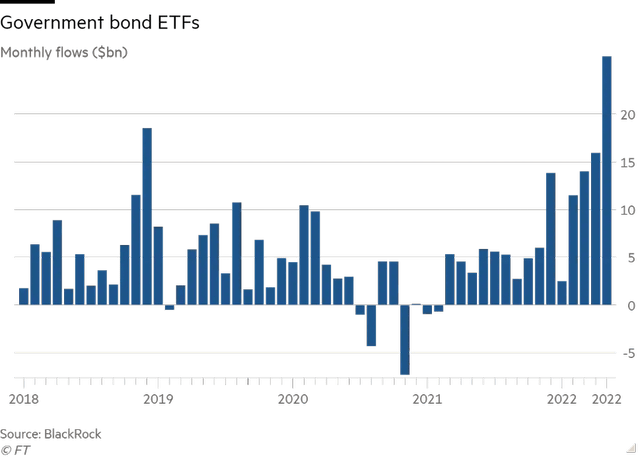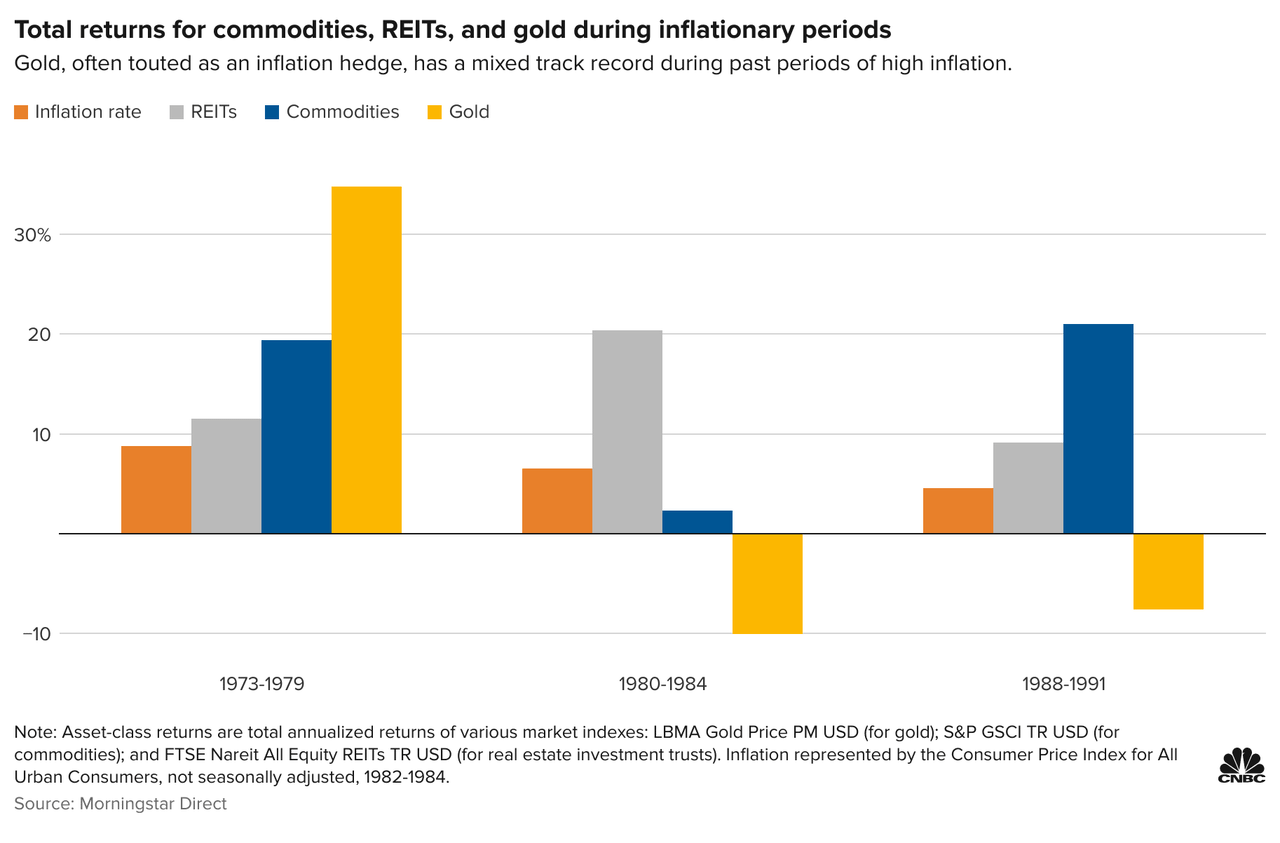chonticha wat
Back in April 2020, I said that the price of gold (XAUUSD:CUR) ‘could be setting up for a 2020 high’. The price topped out in August of that year and the retest in 2021 could not breach that level. There is now a risk that the price of the precious metal falls to $1,400 and I will explain how it can get there.
My call for a 2020 top in gold turned out to be right
My call in gold back in 2020 was based on the fact that the push to new highs was driven by ETF flows, which were starting to subside.
“Global central banks have committed unprecedented levels of stimulus… warning that the market panic is starting to subside and safe haven demand will wane. As gold prices move higher, volumes in the spot market are not. This is an indicator that the ETF flows are one of the key drivers of this rally,” I said at the time.
For too long investors have been taken advantage of by gold promoters who sell the precious metals and churn out analysis that always talks of an imminent rally: US debt, central banks, and hyperinflation are often the common themes. I will address all of these flawed points in this article.
I have honestly been reading about the demise of the dollar since 2005, based on the US debt levels, but they continue to soar.
US Government Debt (Trading Economics)
The talking heads who have constantly talked of the dollar’s collapse and the end of its global currency status could not see that it is the euro that is the problem. The euro was touted as a replacement for the dollar and it is now at parity and at risk of collapsing further.
I also remember that ahead of the all-time high in the euro in 2008, the rapper Jay-Z recorded a music video flashing wads of euros over dollars. The move even attracted criticism from Jim Cramer for “undermining the already weak dollar”. The Jay-Z move fueled debates about the death of the US dollar and some discussed whether they should be paid in euros.
That is very similar to the stories ahead of the Bitcoin (BTC-USD) high in 2021 where big sports stars began to demand payment of their salaries in BTC.
Those stories just highlight the reality for investors again that sports stars and celebrities are not your friends in the market. The same goes for outfits that sell physical gold and provide you the research to go long.
The price of gold is now testing a big support level
The technical support for gold on a weekly level is at $1,700 and I warned my subscribers of a bearish outlook weeks ago before the big drop through $1,800.
Gold Price (M) (Trading View)
As we move towards the end of July, the monthly chart above is showing a bearish weight that could pierce the $1,700 and there is fresh air below ahead of the $1,400 level. Look at the similar price action in 2012 and you will see that gold went to $1,100 after a break of the support.
For gold to see higher prices then it needs to create a triple bottom at the $1,700 level but it would need a catalyst.
What are the catalysts for a drop to $1,400?
Complex thought requires effort and when it comes time to choose between two paths, our brain will often choose the easier one. Mental effort means exerting energy, and the brain tends to economize – Daniel Kahneman
Sadly, for gold, it is hard to find a catalyst for gains in the present environment. The US dollar is surging and last week’s 9.1% inflation print showed that the chances of the Federal Reserve slowing its rate hikes are looking very unlikely.
It is actually hilarious after the market environment of recent years, that investors cheered this week on hopes that the Fed would hike by ‘only’ 75 bps and not a full 1 percent.
Investors are now turning their attention to “peak inflation” based on a small pullback in commodities and cannot see that aggressive global central bank action has done little to cool inflation. The central banks know that interest rate hikes are not a perfect lever and part of the reason to signal the hikes was to take the heat out of pricing with words, but it has so far only destroyed excess market liquidity.
As Daniel Kahneman says, ‘complex thought requires effort and our brains will often choose the easy path’. In investments, that is to buy into the bullish reasoning for gold and Bitcoin and refuse to adjust your expectations when the outlook changes.
Even Cathie Wood, founder, and CEO of ARK Invest was jumping on board the easy thought train this week with her inflation comments. The ETF creator said that the Fed is making a policy error:
“The market has figured out the Fed is making a mistake,” Wood said, which is why stocks were “in a bottoming process.”
Wood believes that the Fed will have to reverse course due to deflation and recession, while she also pointed to gold which she noted was 8% lower. Gold is “one of the most reliable inflation indicators out there,” Wood said. “Any market says we’re already in recession.”
It is odd that Wood also said almost a month ago that her company missed inflation. “We were wrong on one thing and that was inflation being as sustained as it has been,” she told CNBC.
Like Wood’s call for oil to $12 in 2020, the founder of a company that prides itself on disruptive trends, seems to have an eye on the big picture, and a problem with short-term macroeconomic research.
Her comments highlight the confusion among those who were lauded as geniuses in the Fed’s cheap money experiment. We know all of the gold investor ‘gurus’ who also make their predictions based on large, disruptive trends that never materialize. But the Federal Reserve is always there to take the blame.
So, with that in mind, let’s undertake a little more complex thought in gold.
The Financial Times reported recently that,
“Net flows into government bond exchange-traded funds hit a record high in May as deteriorating economic sentiment led investors to batten down the hatches.”
“Purchases of sovereign bond ETFs surged to $26bn, according to data from BlackRock, up from $15.9bn in April and far ahead of the previous monthly record of $18.5bn, set in December 2018,” the FT added.
Government Bond Flows (BlackRock, FT)
Compare those flows to gold ETFs where $3.1 billion flowed OUT of gold in the same month and you will see that professional investors have more trust in government bonds. Like Cathie Wood’s gold-as-inflation-hedge comment, the market loves to cling to these flawed rules that ignore the need for more complex thought. A recent study showed that gold actually has a mixed record during periods of inflation.
Inflation Returns (CNBC, MorningStar)
The outflows in gold are the largest since March 2021, and while ETF flows were 8% higher from the same time a year ago, net long positioning in futures was at the lowest in a year. The selling in the last weeks will have shaken out those numbers again.
Investors are fleeing to government bonds as a safe haven because with soaring interest rates, yield is more important to them. With a choice between the two safe havens, bonds are winning and big money does not want the hassle of gold storage and other issues.
What the gold promoters also do not like to admit is that the surge in ETF flows and futures into gold over the long-term means that the central bank printing era has actually boosted gold via paper markets. Gold ETFs saw an all-time high in 2020 and that is no coincidence that it coincided with the gold price high. Gold is not being helped by inflation and could get hurt further with a deflationary recession.
There will be no hyperinflation
Another favorite selling point for gold promoters is hyperinflation, but again, these theories are loosely based on money printing but without any complex thought applied. In Weimar Germany, the country’s refusal to pay reparations saw foreign troops from Belgium and France move into the industrial hub of the Ruhr Valley to confiscate goods and ended up occupying coal mines, railways, steel works, and factories – the core of the German economy. With no ability to pay workers, the government printed money and handed it straight to workers. Workers who refused to take orders from the invading troops were shot at. So, the underlying reasons for hyperinflation were based on a much bigger problem than money printing. Political instability, invading troops, industrial activity shut down, and workers being threatened created a toxic mix.
The Federal Reserve creating bonds that were then parked back at the bank for interest in a politically stable environment was a very different animal.
Economist Martin Armstrong summed it up in his October 2021 report: Why There Will Be No Hyperinflation:
“While people point to Germany or Zimbabwe as examples and harp on the central banks creating money, they then conclude the other dollar will turn to dust and the only survivor will be gold. In truth, never has the core economy gone into hyperinflation and all peripheral economies survive. For the dollar to turn to dust, the entire rest of the world must go first. The US has the largest single debt, but it also has the largest economy.”
Investors need to break the cycle of listening to false experts who have been constantly wrong. I predicted the top in gold based on an analysis of the underlying drivers and saw recently that there was a risk of a drop below $1,800.
Gold is now testing key support at $1,700 and the price action above that means that a failure could take the price of the precious metal to $1,700. The dollar is not about to fail, hyperinflation is not coming and the underlying ETF and futures demand is waning in gold. All eyes should be on the Federal Reserve and inflation.
Conclusion
I was right about gold topping out in 2020 and despite a retest of the high, it could not get higher. The price action is now very similar to 2012, which saw the price go as low as $1,100. In recent weeks I warned in my newsletter that bearishness could lead to a sell-off and a test of $1,700. That has happened and we are now at a crossroads. Gold may hold this level and avoid a move to $1,400 but investors should be warned. Many have lost fortunes over the last two decades waiting for a dollar collapse and hyperinflation and this time is no different. The real test for gold in the coming weeks will depend on the Federal Reserve and higher inflation will continue to have an adverse effect on gold, while a deflationary trend will also remove speculative flows.


Be the first to comment